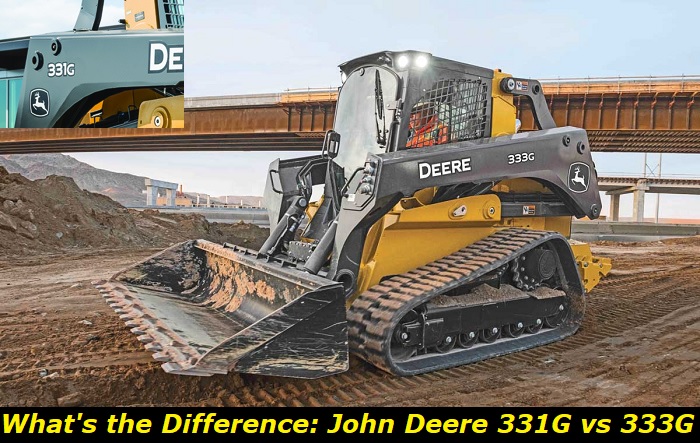John Deere 331G vs 333G - What's the Difference?
John Deere compact loaders and skid steers rank among the best in the market. JD has been manufacturing various compact track loaders to provide a wider option for clients in different sections in agriculture, construction, and forestry applications. One of the most popular compact track loaders is in the G-Series which boasts of four distinct loaders suited for different operations.
In our article today, we shall try to differentiate between two of the most popular G-Series compact track loaders manufactured by JD- the 331G and 333G. In the article, we shall look at the specs for each loader, load output, reliability, engine output, and common problems. We shall also give a brief introduction to what a compact loader is and the difference between them and skid steers.

The JD Compact Loaders
The John Deere compact track loaders are classified into three categories based on their frames- small, medium, and large. The G-Series has the JD 317G as the small frame loader, and JD 325G as the medium frame loader, while the JD331G and JD333G complete the classes in the large frame class. In our article, we shall dwell on the large frame 331G and 333G compact track loaders.
The JD compact large frame track loaders are equipped with an EH Boom performance package that is intended to maximize productivity to the desired level of the customer. This package speeds up all the repetitive movements and shortens the cycle times for all operations. Additionally, these compact track loaders come with a host of auxiliary attachments including:
· Buckets
· Grading attachments
· Brooms
· Bale spears
· trenchers
· Huggers
· Silage defacers
· Pallet forks
· Rotary cutters, and,
· Augers
Having different loaders with different dimensions and specs helps customers select the loader that fits their job specifications and logistical requirements. This informed the decision by JD to have various categories of loaders within the G Series. The decision to have two almost identical but competing large frame loaders was informed by the assertion that large tractors outperform the smaller frame tractors.
The JD compact loaders have a special design vertical lift that rises high up for quick and easy loading. They have operating capacities of between 965- 1680 kg (2125-3700 pounds) and have a superior ability to operate in tight spaces.
These compact loaders have a high operating weight to enable them to perform their duties optimally and efficiently.
What is a compact track loader?
Compact track loaders are very similar, and often confused with skid steers/loaders. The two are used for similar applications, the difference coming in weight and movement. Compact track loaders are heavier than skid steers and have tracks for wheels, while on the other hand, skid steers have wheels that 'skid' sideways when turning, hence their name. While a skid steer is quick and easily maneuverable, compact loaders have superior traction and more force.
The JD G Series
The JD G Series is popular for its reliability, low operating costs, high productivity, fair price, and enhanced visibility. The large frame 331G and 333G come with a hi-tech suite control feature for operators to complete tasks easily, quickly, and more accurately. These two loaders have the following identical general specs:
· They have over 100 attachments for almost any work available such as bale handling, grading, and V-pattern loading among others.
· The cabin is equipped with a rear-view camera, LED lighting, clear visibility, and a Quick-Tatch lock/unlock system indicator.
· A spacious, pressurized cab to keep dust and water out, reduce noise levels to the minimum, and keep the operator fresh.
· An ergonomically designed foot space creates extra space for foot repositioning for maximum operator comfort
· They have longer times between successful services to increase the amount of time available for work.
· They also come with easily accessible service points to reduce the time taken for actual servicing
· EH boom performance package with ABCDE operation sections for increased productivity which applies automated shorter cycles for repetitive functions such as RTC (return to carry), RTD (return to dig), and BHKO (boom height kick out).
However, despite these similarities, there are marked differences in terms of body/frame dimensions and loader operations/functions.
The two loaders differ in several aspects including engine power, length (with no attachments), operating weight, tipping load capacity, and bucket breakout force among many other differences. Moreover, the 333G comes loaded with state-of-the-art blade control and operating solutions that place it far ahead of the 331G (and other loaders in the same category).
1) The JD 331G
In addition to the above features, the 331G comes loaded with the following:
· An array of controls for the operator to choose from, ranging from the ISO H-pattern and Foot controls to the ISO Plus foot controls to fit the job at hand.
· Easily reachable controls allow for easier repetitive movements to reduce tedious routines
· Easy-to-mount cabin equipped with multiple slip-resistant steps and easily accessible handles in and out of the machine
· State-of-the-art HVAC (heating, ventilation, air conditioning) system that enables the operator to be comfortable in all seasons.
· The loader has a gross power output of 68kW (91.2hp), a lift height of 3.35m (132 inches), a pump flow rate of 138 litres per minute, and a bucket breakout force of 3450kg (7,600 pounds).
The JD 331G has an anti-stall engine system that allows the operator to engage for maximum horsepower output for efficiency when pushing large loads to prevent engine stall. The loader's differential steering enables the operator to maintain stability in speed and traction when turning the loader. Additionally, it comes with a standard two-speed drive system that achieves up to 8 miles per hour (about 13 km/hr), hence enabling the operator to move quickly from one point to the other.
The loader has easily accessible parts and sections for servicing and maintenance. The hood tilts upwards to allow easy access to filters, dipsticks, reservoirs, and other fluid fillers. The cab can be swung open within five minutes to access the drive-train, while it has removable light side panels and a foot-well for servicing and cleaning.
2) The JD 333G
The 333G is the first loader with a fully integrated 3D SmartGrade control that utilizes engineering drawings for working on various slope sizes and angles. The solution uses 3D precision control while still maintaining the productivity and versatility of the standard JD loader.
Additionally, other grade control solutions such as the 2D Laser Slope Control for optimized cutting and spreading mechanisms can also be installed.
This solution leverages the modern key features of the JD compact loaders which include:
· New design dozer blade
· EZ grade software
· Factory calibration, and,
· Dozer mode
These features allow the loader to have maximum accuracy and productivity.
Alongside these solutions are all other standard features that are available with the JD 333G that give it a massive advantage over the other loaders regardless of the workload or job site.
The 333G has the following other key specs
· 6-way dozer blade able to cut rough grade as well as precise fine grading using the SmartGrade solutions.
· Dozer mode is activated through a push button in the SSM module that enables all machine functions like in the crawler dozer.
· EZ software is used to stabilize the dozer blade for fine and smooth grading even with manual operation.
· Increased hydraulic flows and optional hi-flow hydraulics allow the operator to have greater control and power output with the attachments.
· Well-protected auxiliary couplers and hoses which are internally mounted with CORDURA brand fabric sleeves for better protection.
· Several attachments be connected electrically using the Quick-Tatch systems without the operator having to leave the cab
· Operators can perform full hydraulic and power tasks with precision using the Joystick Performance Package while driving at very low speeds.
· The loader has a large entry, tight out-swinging doors, spacious legroom, and a simplified entry/exit point for ease of operation and comfort
· The 333G boasts a uniquely designed Tri-Cool engine that prevents debris build-up and makes use of large coolers to protect the engine during extraneous load conditions.
It has an onboard fully integrated grade monitor system that displays the main-fall and cross-slope blade operations. The display, in percentages or degrees, provides the operator with real-time grade checks that eliminate the need for outside checks.
The 333G has an auto slope control system that adjusts the blade automatically to a pre-determined slope angle or flat pad. A laser mounted on the blade for this function enables real-time blade control for the cross-slope and main fall for the specified target areas in percentages.
The 333G's boom is designed to keep the load close to the loader to enhance stability. Additionally, a low COG, optional ride controls, and a bucket rollback of 35 degrees maintain the bucked full load and fork.
Below is a summary of some of the key differences between the JD 331G and the JD 333G
|
Model |
Engine HP |
Length (With no bucket) |
Ground Pressure |
Operating Capacity |
Tipping Load |
Operating weight |
Bucket Force (BKO) |
|
331G |
88.5 |
3100mm |
11,900 lbs |
1407kg |
4021kg |
5403kg |
3450kg |
|
333G |
96.6 |
3710mm |
12,100 lbs |
1680kg |
4799kg |
5493kg |
4200kg |

Add comment